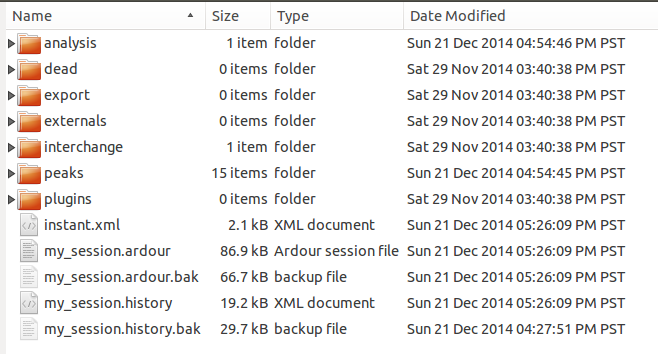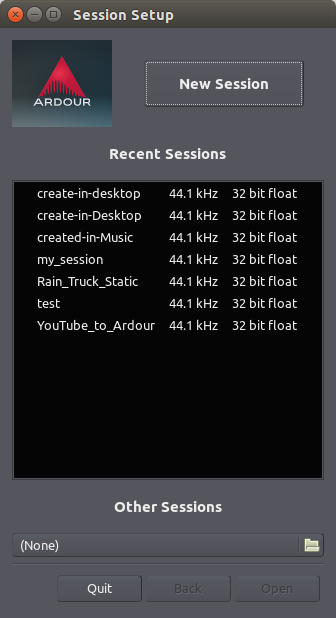“Ardour4 初学者教程 05 导出会话”的版本间的差异
来自Ubuntu中文
(以内容'=导出一个会话= [http://brunoruviaro.github.io/ardour4-tutorial/saving-a-session/ (原文)] =导出工作区= [http://brunoruviaro.github.io/ardour4-tutorial/savin…'创建新页面) |
(→导出一个会话) |
||
| 第1行: | 第1行: | ||
=导出一个会话= | =导出一个会话= | ||
[http://brunoruviaro.github.io/ardour4-tutorial/saving-a-session/ (原文)] | [http://brunoruviaro.github.io/ardour4-tutorial/saving-a-session/ (原文)] | ||
| + | |||
| + | There are a number of ways to save Sessions in Ardour, so that each Session can be use later on. The simplest way is to save the entire Session just like you would save other documents: hitting “Control” + “S”. | ||
| + | |||
| + | A new Session is first saved at the moment you create it. While you are working on it, you should save it frequently. Get into the habit of hitting “Control” + “S” (or “Command” + “S” on a Mac) every few minutes. | ||
| + | |||
| + | TIP: Avoid using any characters other than letters and numbers when naming your session. Avoid white spaces, accented letters, !@#$%*()+, periods, commas, etc. Use dashes or underscores if you like. For example, instead of “My Great Session!”, prefer “My_Great_Session”, or “MyGreatSession”, or “my-great-session”. Instead of “Açaí”, write “Acai” (without accented letters), etc. Once you have created your Ardour session, do not manually rename any folders or files that belong to the Session. | ||
| + | |||
| + | ==Ardour File and Folder Format== | ||
| + | |||
| + | The contents of a typical Session’s folder on your hard drive might look something like this: | ||
| + | |||
| + | http://brunoruviaro.github.io/ardour4-tutorial/images/Ardour4_Session_Folder_Structure.png | ||
| + | |||
| + | A bit of information about some of the components inside that folder: | ||
| + | |||
| + | The name of this Session is “my_session”. | ||
| + | The main session file is called “my_session.ardour”. The Session file is periodically backed up by Ardour with a .bak extension. | ||
| + | The .history file keeps a record of changes you have made during your Session, and is also periodically backed up. | ||
| + | The interchange folder contains the actual audio data of all the Regions used in your Session. | ||
| + | The export folder is where exported files are saved by default. | ||
| + | |||
| + | TIP: If double-clicking on the session file does not launch Ardour, use the standard method of first opening the application itself, then choosing a session from the Session Setup dialog. | ||
| + | |||
| + | http://brunoruviaro.github.io/ardour4-tutorial/images/Ardour4_Session_Setup_Dialog.png | ||
| + | |||
| + | ==Moving a session to another computer or disk== | ||
| + | |||
| + | If you need to move your Ardour session to another computer, or if you would like to make a backup of it on an external drive, you must copy the entire folder containing all of the files mentioned above. It is not enough to copy just the *.ardour file. | ||
| + | |||
| + | TIP: When copying an Ardour folder to another computer or drive, do not manually change its name or the name of any of the internal files. | ||
| + | |||
=导出工作区= | =导出工作区= | ||
[http://brunoruviaro.github.io/ardour4-tutorial/saving-a-snapshot/ (原文)] | [http://brunoruviaro.github.io/ardour4-tutorial/saving-a-snapshot/ (原文)] | ||
2015年10月28日 (三) 21:32的版本
目录
导出一个会话
There are a number of ways to save Sessions in Ardour, so that each Session can be use later on. The simplest way is to save the entire Session just like you would save other documents: hitting “Control” + “S”.
A new Session is first saved at the moment you create it. While you are working on it, you should save it frequently. Get into the habit of hitting “Control” + “S” (or “Command” + “S” on a Mac) every few minutes.
TIP: Avoid using any characters other than letters and numbers when naming your session. Avoid white spaces, accented letters, !@#$%*()+, periods, commas, etc. Use dashes or underscores if you like. For example, instead of “My Great Session!”, prefer “My_Great_Session”, or “MyGreatSession”, or “my-great-session”. Instead of “Açaí”, write “Acai” (without accented letters), etc. Once you have created your Ardour session, do not manually rename any folders or files that belong to the Session.
Ardour File and Folder Format
The contents of a typical Session’s folder on your hard drive might look something like this:

A bit of information about some of the components inside that folder:
The name of this Session is “my_session”. The main session file is called “my_session.ardour”. The Session file is periodically backed up by Ardour with a .bak extension. The .history file keeps a record of changes you have made during your Session, and is also periodically backed up. The interchange folder contains the actual audio data of all the Regions used in your Session. The export folder is where exported files are saved by default.
TIP: If double-clicking on the session file does not launch Ardour, use the standard method of first opening the application itself, then choosing a session from the Session Setup dialog.

Moving a session to another computer or disk
If you need to move your Ardour session to another computer, or if you would like to make a backup of it on an external drive, you must copy the entire folder containing all of the files mentioned above. It is not enough to copy just the *.ardour file.
TIP: When copying an Ardour folder to another computer or drive, do not manually change its name or the name of any of the internal files.